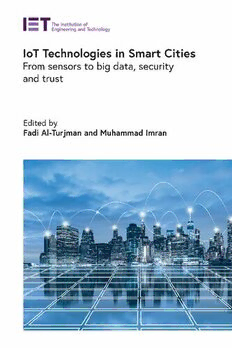Table Of ContentIETCONTROL,ROBOTICSANDSENSORSSERIES128
IoT Technologies in Smart Cities
IETInternationalBookSeriesonSensing–CallforAuthors
Theuseofsensorshasincreaseddramaticallyinallindustries.Theyarefundamentalinawide
rangeofapplicationsfromcommunicationtomonitoring, remoteoperation, processcontrol,
precision and safety, and robotics and automation. These developments have brought new
challengessuchasdemandsforrobustnessandreliabilityinnetworks,securityinthecommu-
nicationsinterfaceandclosemanagementofenergyconsumption.ThisBookSeriescoversthe
researchandapplicationsofsensortechnologiesinthefieldsofICTs,security,tracking,detection,
monitoring,controlandautomation,robotics,machinelearning,smarttechnologies,production
andmanufacturing,photonics,environment,energyandtransport.BookSeriesEditorialBoard
● Dr.HartmutBrauer,TechnischeUniversitätIlmenau,Germany
● Prof.NathanIda,UniversityofAkron,USA
● Prof.EdwardSazonov,UniversityofAlabama,USA
● Prof.Desineni“Subbaram”Naidu,UniversityofMinnesotaDuluth,USA
● Prof.WuqiangYang,UniversityofManchester,UK
● Prof.SheraliZeadally,UniversityofKentucky,USA
Proposalsforcoherentlyintegratedinternationalmulti-authorededitedorco-authoredhand-
books and research monographs will be considered for this Book Series. Each proposal will
bereviewedbytheIETBookSeriesEditorialBoardmemberswithadditionalexternalreviews
from independent reviewers. Please email your book proposal to vmoliere@theiet.org or
author_support@theiet.org.
IoT Technologies in Smart Cities
From sensors to big data, security
and trust
Edited by
Fadi Al-Turjman and Muhammad Imran
TheInstitutionofEngineeringandTechnology
PublishedbyTheInstitutionofEngineeringandTechnology,London,UnitedKingdom
TheInstitutionofEngineeringandTechnologyisregisteredasaCharityinEngland&Wales
(no.211014)andScotland(no.SC038698).
©TheInstitutionofEngineeringandTechnology2020
Firstpublished2020
ThispublicationiscopyrightundertheBerneConventionandtheUniversalCopyright
Convention.Allrightsreserved.Apartfromanyfairdealingforthepurposesofresearch
orprivatestudy,orcriticismorreview,aspermittedundertheCopyright,Designsand
PatentsAct1988,thispublicationmaybereproduced,storedortransmitted,inany
formorbyanymeans,onlywiththepriorpermissioninwritingofthepublishers,orin
thecaseofreprographicreproductioninaccordancewiththetermsoflicencesissued
bytheCopyrightLicensingAgency.Enquiriesconcerningreproductionoutsidethose
termsshouldbesenttothepublisherattheundermentionedaddress:
TheInstitutionofEngineeringandTechnology
MichaelFaradayHouse
SixHillsWay,Stevenage
Herts,SG12AY,UnitedKingdom
www.theiet.org
Whiletheauthorsandpublisherbelievethattheinformationandguidancegiveninthis
workarecorrect,allpartiesmustrelyupontheirownskillandjudgementwhenmaking
useofthem.Neithertheauthorsnorpublisherassumesanyliabilitytoanyoneforany
lossordamagecausedbyanyerrororomissioninthework,whethersuchanerroror
omissionistheresultofnegligenceoranyothercause.Anyandallsuchliability
isdisclaimed.
Themoralrightsoftheauthorstobeidentifiedasauthorsofthisworkhavebeen
assertedbytheminaccordancewiththeCopyright,DesignsandPatentsAct1988.
BritishLibraryCataloguinginPublicationData
AcataloguerecordforthisproductisavailablefromtheBritishLibrary
ISBN978-1-78561-869-7(hardback)
ISBN978-1-78561-870-3(PDF)
TypesetinIndiabyMPSLimited
PrintedintheUKbyCPIGroup(UK)Ltd,Croydon
Contents
Abouttheeditors xi
Forewordandoutline xiii
1 Accesscontrolapproachesforsmartcities 1
NurayBaltaciAkhuseyinogluandJamesJoshi
1.1 Introduction 1
1.2 Smartcities 3
1.2.1 Whatisasmartcity? 3
1.2.2 Smartcityapplications 4
1.2.3 Keyenablingtechnologiesforsmartcities 5
1.3 Securityandprivacychallenges 10
1.3.1 Uniquecharacteristicsofsmartcityapplications 10
1.3.2 Privacy 11
1.3.3 Secureinteroperation 12
1.3.4 Insiderattacks 12
1.3.5 Trustmanagement 13
1.4 ACapproachesforsmartcities 14
1.4.1 ACmodels 14
1.4.2 ACmodelsandframeworksforsmartcityandsmartcity
applications 17
1.4.3 ACmodelsandframeworksforsecureinteroperation 21
1.4.4 Trust-basedACmodelsandframeworks 27
1.4.5 ACmodelsandframeworksforinsiderthreats 31
1.5 Futureresearchdirectionsandperspectives 34
1.6 Conclusions 34
Acknowledgment 35
References 35
2 ImpactofInternetofThingsinsmartcities 41
BhawanaRudra
2.1 Introduction 41
2.2 Smartcity 42
2.3 IoTtechnologiesforsmartcities 42
2.4 Smartcity:IoTapplications 45
2.4.1 Smartinfrastructure 45
2.4.2 Smartbuildingandproperties 47
vi IoTtechnologiesinsmartcities
2.4.3 Smartindustrialenvironment 48
2.4.4 Smartcityservices 48
2.4.5 Smartenergymanagement 49
2.4.6 Smartwaterandweathermanagement 49
2.4.7 Smartwastemanagement 50
2.5 Applications:worldwide 50
2.5.1 International-usecases 50
2.5.2 National-usecases 52
2.6 Challengesandfuturedirections 54
2.7 Conclusion 55
References 55
3 IoT-basedsmartwater 63
HiteshMohapatraandAmiyaKumarRath
3.1 Smartcity 63
3.1.1 IoTintraditionalcity 65
3.1.2 Mythsaboutsmartcities 66
3.1.3 IoTforcommunicationinsmartcities 68
3.2 Smartwater 68
3.3 SWchallenges 70
3.3.1 Assetmaintenance 71
3.3.2 Leakagemaintenance 71
3.3.3 SWmeteringmaintenance 71
3.3.4 Challenges 72
3.4 ProposedstructureforSW 72
3.5 IoTassolution 74
3.5.1 IoTinassetmaintenanceandleakagedetection 75
3.5.2 IoTinSWmetering 76
3.5.3 IoTinSWbottle 76
3.5.4 IoTinSWdistributionnetwork 76
3.5.5 IoTinSWirrigation 77
3.5.6 IoTinremotecontrollingofSWassets 77
3.5.7 IoTforSWpricingorrevenuegeneration 77
3.5.8 IoTforsmartbillingforSW 77
3.5.9 IoTformeasuringdeepwaterquality 78
3.5.10 IoTforpredictingwater-basednaturalcalamities 78
3.6 Lessons 78
3.7 Conclusion 79
References 79
4 Contiki-OSIoTdataanalytics 83
MuhammadRafiq,GhazalaRafiq,HafizMuhammadRazaurRehman,
YousafBinZikria,SungWonKim,andGyuSangChoi
4.1 Introduction 84
4.2 ContikiOS 85
Contents vii
4.3 Contiki-OSmessagestructures 88
4.4 Mathematicalformulasforrequiredstatistics 90
4.5 Proposedalgorithms 92
4.6 Resultsanddiscussion 96
4.7 Conclusion 102
References 102
5 AnalysisofthesafetyoftheInternetofThingsinthemesh 105
MikołajLeszczuk
5.1 Introduction 105
5.2 SecurityoftheIoT 107
5.2.1 X.509 107
5.2.2 OpenTrustProtocol 108
5.3 SafetyaspectsintheIEEE802.15.4standard 109
5.4 Technicalguidelinesforsecurelytransferringinformation
betweenselectedIoTmeshpoints 111
5.4.1 Networkingmodes 111
5.4.2 Typesofcommunication 113
5.5 SecurityoftheimplementationofthemeshIoT 114
5.5.1 Bluetoothmeshnetworking 115
5.5.2 Disruption-tolerantmeshnetwork 117
5.5.3 ELIoTPro 117
5.5.4 LoRa 118
5.5.5 Thread 120
5.5.6 Z-Wave 120
5.5.7 Zigbee 121
5.6 Comparisonofsecurityaspectsindifferentnetworks 123
5.7 Summary 124
References 124
6 Designofsmarturbandrainagesystemsusingevolutionary
decisiontreemodel 131
MirJafarSadeghSafariandAliDanandehMehr
6.1 Introduction 131
6.1.1 Overviewofdrainagesystemsdesigncriteria 133
6.1.2 Overviewofmachinelearningapplicationindrainage
systemsdesign 135
6.2 Materialsandmethods 135
6.2.1 Experimentaldata 135
6.2.2 Datapreparation 136
6.2.3 Performanceindices 136
6.2.4 Decisiontree 137
viii IoTtechnologiesinsmartcities
6.2.5 GPmodel 138
6.2.6 HybridEDTmodel 140
6.2.7 Comparisonofmodels 141
6.2.8 IoTapplicationsindrainagesystems 143
6.3 Conclusions 144
References 145
7 StatisticalanalysisforsensoryE-Healthapplications:opportunities
andchallenges 151
HakanYektaYatbazandAliCevatTas¸ıran
7.1 Introduction 152
7.2 Background 153
7.3 Dataset 156
7.3.1 Arubatestbed 156
7.3.2 Datasetandactivities 156
7.3.3 Datapreparation 157
7.4 Opportunitiesanddirections 159
7.5 Conclusion 166
References 167
8 CybersecurityattacksonmedicalIoTdevicesforsmartcity
healthcareservices 171
MarinaKarageorgou,GeorgiosMantas,IsmaelEssop,
JonathanRodriguezandDimitriosLymberopoulos
8.1 Introduction 171
8.2 Smartcityhealthcare 172
8.2.1 Overview 172
8.2.2 Smartcityhealthcaresystems 173
8.2.3 Benefitsarisingfromsmartcityhealthcare 175
8.3 IoTmedicaldevicesforsmartcityhealthcaresystems 175
8.3.1 Overview 175
8.3.2 MedicalIoTdevicessecurityobjectives 176
8.4 CybersecurityattacksonmedicalIoTdevices 177
8.4.1 Attackvectors 178
8.4.2 Post-compromiseactions 179
8.4.3 Impact 180
8.4.4 Impactevaluation 180
8.5 Securitycountermeasures 181
8.5.1 Ensuringconfidentialityandintegrity 181
8.5.2 Ensuringavailability 182
8.5.3 Ensuringauthenticationandauthorization 183
8.5.4 Ensuringnonrepudiation 183
8.6 Emerginggoodpracticeandapproaches(standards) 184
8.7 Conclusionsandfurtherchallenges 185
References 185
Contents ix
9 HaLow:registeringthousandsoflow-powersensorsinsmartcities 189
RashidAli,NurullahShahin,FadiAl-Turjman,Byung-SeoKim,
andSungWonKim
9.1 Introduction 190
9.2 IEEE802.1ahHaLow:anoverview 191
9.2.1 UsecasesforHaLow 192
9.2.2 HaLowMAClayer 193
9.3 Linkset-upinHaLownetworksformassiveIoTdevices
registration 194
9.3.1 Linkset-upinWLANs 194
9.3.2 Distributedauthenticationcontrol 196
9.3.3 Centralizedauthenticationcontrol 196
9.4 Casestudy:hybridslotted-CSMA/CA-TDMA 197
9.4.1 SIFTgeometricdistribution 199
9.4.2 ExpectednumberofAuthReqframesinaC-Slot 201
9.5 Conclusions 203
References 204
10 Statisticalanalysisoflow-powersensormotesusedin
IoTapplications 207
AliCevatTasiranandBurakKizilkaya
10.1 Introduction 207
10.2 Literaturereview 208
10.3 Dataset:Mica2Dotsensorsandstatisticalanalysis 210
10.3.1 Descriptiveanalysis 210
10.3.2 Linearregressionmodel(ordinaryleastsquares
estimates) 214
10.3.3 Orderedlogitmodels 216
10.4 Conclusionandfutureworks 224
References 224
AppendixA:Variablesbydurationgroups 227
11 Conclusionsandrecommendations 229
FadiAl-Turjman
Index 233

